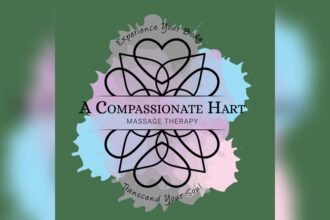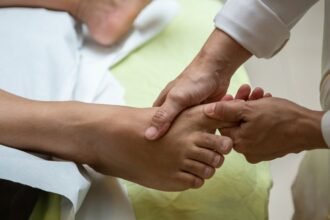Ever wondered if you could speed up your recovery after hip replacement surgery? The secret might be right at your fingertips. Scar massage, a simple yet powerful technique, could be the key to unlocking better mobility and reducing discomfort. But how exactly does it work, and when should you start?
I’ve put together this guide to help you navigate the world of hip replacement scar massage. With the number of total hip replacements in the U.S. expected to hit 850,000 by 2030, it’s crucial to understand how to care for your surgical site. Proper scar tissue massage techniques can make a world of difference in your recovery journey.
In this guide, I’ll walk you through the ins and outs of post-surgery scar massage. You’ll learn why it’s important, when to start, and how to do it effectively. Whether you’re preparing for surgery or already on the road to recovery, this information will be invaluable in your healing process.
Key Takeaways
- Scar massage can speed up recovery after hip replacement surgery
- Hip replacement surgeries are on the rise in the United States
- Proper massage techniques can improve mobility and reduce discomfort
- Timing is crucial when starting scar massage
- This guide provides essential information for effective scar tissue management
Understanding Hip Replacement Scars
Hip replacement surgery often leaves scars. Let’s look at what these scars are, how they form, and why managing them is key for recovery.
What are surgical scars?
Surgical scars are marks on the skin after an incision heals. They happen as the body fixes the wound, making new tissue. Scars look different based on skin type, age, and how the surgery was done.
How do hip replacement scars form?
Scar formation starts right after surgery. The body quickly tries to close the wound, making collagen fibers to make it stronger. The scars from hip replacement can look different based on the surgery method:
- Anterior approach: Smaller scar at the front of the hip
- Posterior approach: Longer scar on the side or back of the hip
The importance of scar management
Managing scars well is crucial for healing and function. It can lessen pain, boost mobility, and make scars less noticeable. Good methods include massage, moisturizing, and avoiding sun exposure.
| Scar Management Technique | Benefits |
|---|---|
| Massage | Improves circulation, reduces adhesions |
| Moisturizing | Keeps skin supple, prevents itching |
| Sun protection | Prevents darkening, reduces visibility |
Understanding surgical scars and using the right scar management can greatly help recovery after hip replacement surgery.
Benefits of Massaging Your Hip Replacement Scar

Scar massage is great for those who’ve had hip replacement surgery. It can really help with healing and feeling better. Let’s look at some of the main benefits of this simple method.
One big plus is that it helps prevent scar tissue from sticking to other parts. This keeps the hip area flexible and mobile.
It also makes scars softer and flatter. By applying pressure and moving the scar, we help collagen form better. This can make the scar less noticeable over time.
- Decreases itchiness and sensitivity
- Improves blood circulation to the area
- Promotes better overall healing
- Enhances range of motion in the hip joint
Scar massage can also make surgical scars less painful. It reduces itching and sensitivity, making everyday tasks easier. Plus, it boosts blood flow, helping the area heal faster.
Another key advantage is better hip movement. Massage breaks up scar tissue, making muscles and tissues more flexible. This improves hip flexibility and movement.
“Scar massage has been a game-changer in my recovery. It’s helped me regain flexibility I thought I’d lost for good.”
Adding scar massage to your recovery routine is a smart move. It offers more than just physical benefits. It also gives you a sense of control and involvement in healing.
When to Start Scar Massage After Surgery
Timing is key for post-operative scar massage. If you’ve had hip surgery, you’re probably eager to start healing. Let’s look at when it’s okay to start massaging your hip replacement scar.
Typical Healing Timeline
Most doctors say wait about 6 weeks before massaging your scar. This gives your incision time to heal. During this time, rest and follow your doctor’s advice for recovery.
Consulting with Your Healthcare Team
Your doctor knows your situation best. Always check with your healthcare team before starting scar massage. They can give you advice based on your healing and health.
Signs Your Scar is Ready for Massage
Here are signs your scar is ready for massage:
- The incision edges are well-closed with no gaps
- There’s no drainage from the wound
- The scab has fallen off naturally
- The scar isn’t painful to touch
Everyone heals at their own pace. Some might be ready sooner, others later. Listen to your body and your healthcare team’s advice on when to start scar massage for your hip replacement.
Preparing for Scar Massage: Essential Steps

Getting ready for scar massage is key to safe and effective treatment. I’ll show you how to prepare for scar massage after hip replacement surgery.
First, wash your hands well with soap and warm water. This is crucial to prevent infection and keep your scar clean. Dry your hands completely with a clean towel.
Next, ensure your skin is dry and free from lotions or oils. If you’ve showered, wait a bit before starting the massage. Warm, clean skin is easier to massage.
Choose a comfy position that doesn’t hurt your hip. You might lie down or sit in a supportive chair. The goal is to relax and avoid tension during the massage.
Have your massage products ready. This could be a water-based cream or scar treatment oil. Keep them within reach to avoid stopping your massage.
- Clean hands and dry skin
- Comfortable, relaxed position
- Massage products nearby
Remember, proper preparation is vital for the best results. If you feel pain or discomfort, stop and talk to your healthcare provider before continuing.
How to Massage Scar After Hip Replacement

Learning how to massage a scar after hip replacement can really help your recovery. Scar massage techniques can make your scar less stiff and help it heal better. Let’s look at three good ways to massage your hip replacement scar.
Towards the Scar Technique
This method means moving the skin around the scar towards its center. I gently push the skin inward, using firm but gentle pressure. This helps break down the scar tissue and makes it more flexible.
Back and Forth Method
I use my fingertips to move the skin and tissue under the scar back and forth. This action loosens tight spots and boosts blood flow. I make sure to cover the whole scar, focusing on any stiff areas.
Circular Massage Technique
In this method, I use small circular motions on the scar. I apply enough pressure to feel the scar “move” without pain. This technique is great for softening the scar tissue and boosting flexibility.
| Technique | Motion | Pressure | Benefits |
|---|---|---|---|
| Towards the Scar | Inward push | Firm | Breaks down scar tissue |
| Back and Forth | Linear movement | Moderate | Improves blood flow |
| Circular | Small circles | Gentle to moderate | Softens scar tissue |
Consistency is important when using these scar massage techniques. By adding these methods to your daily routine, you can improve your hip replacement recovery and make your scar look better.
Recommended Frequency and Duration of Scar Massage
Creating a regular scar massage routine is key for healing after hip replacement surgery. The right frequency and duration can greatly help your recovery.
I suggest massaging your hip replacement scar 2 to 3 times a day. Each massage should last about 5 minutes. Keep this up for 6 months to a year after surgery.
Being consistent with scar massage is crucial. Regular sessions help your scar heal well and look less noticeable.
| Aspect | Recommendation |
|---|---|
| Scar Massage Frequency | 2-3 times daily |
| Duration of Scar Massage | 5 minutes per session |
| Total Treatment Period | 6 months to 1 year |
If you’re getting radiation treatment, stop your scar massage. Start again when your skin heals. Always check with your doctor about the best massage schedule for you.
Choosing the Right Products for Scar Massage
Choosing the right scar massage products is key for treating hip replacement scars. I’ll help you find the best options.
Water-based Creams
Water-based creams are great for scar massage. They offer the right amount of lubrication without being too oily. Aqueous cream or E45 hand cream are favorites among patients and therapists.
Specialized Scar Treatment Products
There are many creams made just for scar massage after surgery. These creams often have silicone to help scars look less noticeable. Mederma and BioCorneum are well-liked choices.
Natural Oils for Scar Massage
Natural oils are also good for scar massage. Coconut oil, vitamin E oil, and rosehip oil are popular. Always check with your doctor before trying new products on your scar.
| Product Type | Examples | Benefits |
|---|---|---|
| Water-based Creams | Aqueous cream, E45 | Good lubrication, less sliding |
| Specialized Products | Mederma, BioCorneum | Contains scar-reducing ingredients |
| Natural Oils | Coconut oil, Vitamin E oil | Natural ingredients, moisturizing |
When picking scar massage products, stay away from strong fragrances or irritants. Your skin might be sensitive after surgery. So, choose gentle, hypoallergenic options.
Potential Risks and Precautions
Scar massage can be helpful, but it’s important to know the risks. Too much pressure or rough techniques can harm healing tissue. So, it’s key to take precautions.
I found out about some scar massage risks during my recovery. If you feel more pain, redness, or swelling, stop right away and talk to your doctor. These signs might mean there’s a problem.
People with posterior hip replacements need extra care. I had to watch my movements closely. Here are some things I avoided:
- Not bending the hip beyond 90 degrees
- Avoiding crossing legs
- Limiting internal rotation of the hip
To make sure scar massage was safe, I followed these steps:
| Precaution | Reason |
|---|---|
| Use gentle pressure | Prevents tissue damage |
| Clean hands before massage | Reduces infection risk |
| Stop if pain increases | Avoids further injury |
| Follow doctor’s instructions | Ensures proper healing |
Keep in mind, everyone heals differently. It’s crucial to talk to your healthcare team about any worries or unusual signs during scar massage.
Complementary Therapies for Scar Management
I’ve discovered that using complementary scar therapies can really help after hip arthroplasty. These methods work well with traditional treatments to aid in healing and lessen pain. Let’s look at some effective options.
Lymphatic Drainage Massage
Lymphatic drainage massage is a soft technique that helps cut down swelling and pain. It boosts the lymphatic system to clear out extra fluid from tissues. This is very helpful in the early recovery stages after hip replacement surgery.
Kinesiotaping for Scar Healing
Kinesiotaping uses special elastic tape to support muscles and joints. When used right, it can help manage pain and lessen swelling around the surgery area. I’ve seen great results when combining kinesiotaping with lymphatic drainage for scar management after hip arthroplasty.
Physical Therapy Exercises
Physical therapy exercises are key for getting strength and mobility back after surgery. These exercises work well with scar massage to improve joint function. A custom exercise plan can help reduce scar tissue and promote healing.
Remember, these complementary scar therapies should be done with professional guidance. Always talk to your healthcare team before starting any new treatment. With the right approach, these methods can greatly improve your recovery journey.
Conclusion
Hip replacement scar management is key after surgery. I’ve shared ways to care for your scar. By using these methods and working with your healthcare team, you can improve your recovery.
Proper scar massage can make your scar more flexible and reduce adhesions. Start at the right time and use gentle, consistent pressure. Use water-based creams or natural oils for the best results.
Post-operative scar care needs patience and dedication. Regular massage is a big part of healing. It can lead to better outcomes and a smoother recovery.
Talk to your doctor or physical therapist about these techniques. They can give you advice tailored to your needs. With the right care, you can manage your hip replacement scar and support your body’s healing.
FAQ
What are the benefits of massaging a hip replacement scar?
When can I start massaging my hip replacement scar?
How do I prepare for scar massage?
What techniques should I use for scar massage?
How often and for how long should I massage my scar?
What products are recommended for scar massage?
Are there any risks or precautions I should be aware of?
What complementary therapies can aid in scar management?
Source Links
- Massage Post Joint Replacement Surgery | Massage Therapy Journal – https://www.amtamassage.org/publications/massage-therapy-journal/massage-post-joint-replacement/
- PDF – https://www.stgeorges.nhs.uk/wp-content/uploads/2021/09/Scar-scar-massage.pdf
- At Home: Scar Massage – https://myhealth.alberta.ca/breast-cancer-surgery/at-home/scar-massage













3 Comments
Isnt it counter-intuitive to massage a hip replacement scar? Wont it disrupt the healing process? Interesting article though!
Does massaging hip replacement scars truly aid in healing, or is it more of a placebo effect? Would love to hear experiences.
Interesting guide, but wouldnt massaging a hip replacement scar risk disturbing the healing process? Open to thoughts.